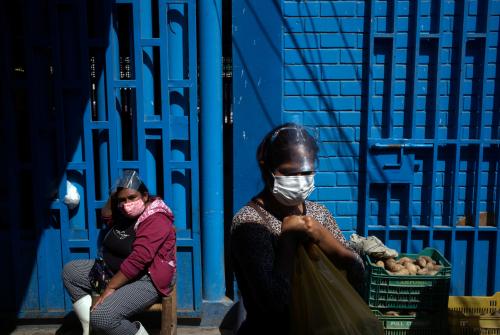In a pandemic, government support to improve people’s ability to cope with health and economic challenges is essential. But at such times even more than others, the government’s assistance is effective only if it reaches the most affected families in time. For Ethiopia, we used the World Bank’s High-Frequency Phone Surveys on COVID-19, 2020 (HFPS) and the Ethiopia Socioeconomic Survey, 2018-19 (ESS) to assess whether families got help during the pandemic, how quickly they got it, and whether government assistance benefited the poorest families.
Ethiopia confirmed its first case of COVID-19 on March 13, 2020. By October 2020, the cumulative number of confirmed cases had reached 96,169, and about 1,469 people had died due to COVID-19. Besides adverse health effects, households experienced food and income shocks. Between March and October 2020, around 8.4 percent of households reported a job loss due to COVID-19. Three in every four households experienced a reduction or total loss of household income. Of these, 32.3 percent used extreme measures such as selling assets or reducing food or nonfood expenditures to cope with the income loss. Moreover, 31.4 percent of the total households reported at least one instance of adult members not having food for an entire day due to a lack of resources.
Despite the detrimental impact of COVID-19 on household income and food security, we found that by October 2020, seven months after the country’s first case of COVID-19 was confirmed, only 13 percent of Ethiopian households had received some form of government assistance. It was more reassuring to find that the proportion of the poorest households receiving government assistance (18 percent) was higher than the national level proportion, indicating the government’s effort to prioritize the poor. Yet, four-fifths of the poorest households were left without any support.
What proportion of families received assistance?
Overall, 16.7 percent of households received some form of assistance from the government, nongovernment sources, or both between March and October 2020. The share of households receiving support declined over time—from 7.9 percent in March-May to 3.4 percent in August-October 2020 (Figure 1).
What type of assistance did Ethiopians get, and from whom?
Food assistance was the most common type of aid received by households from both government and other sources, followed by direct cash transfers and cash/food for work (Figure 1). Around 9.8 percent of households had received food assistance at least once by October 2020. The cash and food/cash for work assistance had reached a meager 5.9 percent and 2.7 percent of households, respectively. Barring a slight increase in households receiving assistance in mid-August, fewer households received support over time regardless of the assistance type.
The government has been the primary assistance provider during the pandemic (Figure 2). However, the government reached only 13 percent of households with some form of assistance by October 2020. In the initial three months, the government provided cash assistance to a higher number of households than the food and food/cash for work assistance. From June 2020, food assistance has been the most common type of government support.
There was a big gap between the percentage of households reporting a reduction in household income and the percentage of households receiving government assistance (Figure 2). For instance, 54.5 percent of households reported experiencing an income shock between mid-March and mid-May 2020. However, only 2.8 percent of households received cash transfers from the government during this period. Similarly, 74.8 percent of households experienced income reduction between mid-March and mid-October, but only 5.2 percent of households ever received government cash assistance in this timeframe.
Did government assistance benefit the poorest people?
Social assistance programs reached less than a fifth of the poorest 40 percent of households within seven months after the pandemic struck. However, Ethiopia was able to target poor families through its existing social protection program (Figure 3). Between March and October 2020, the government provided food assistance to 8.5 percent of poor households (those in the bottom 40 percent of consumption expenditure percentile) compared to 5.1 percent of non-poor households (in the top 60 percent of consumption expenditure percentiles). It was also able to target low-income families better in providing cash assistance (8 percent of poor households vs. 3.2 percent of non-poor households) and food/cash for work (3 percent of poor households vs. 2.4 percent of non-poor households). Most households received cash and food/cash for work assistance through the government’s flagship social protection program, the Productive Safety Net Program (PSNP). The PSPN program has since 2005 provided food and cash assistance to the poorest households in exchange for labor and direct cash transfers to households not able to participate in physical labor.
Was government assistance sufficient?
Although the Ethiopian government could target low-income families, most of them received assistance only once between March and October 2020, and the amount of assistance was minuscule (Figures 4 and 5). Among the poor households that received cash and food assistance from the government until October 2020, 73 percent and 64 percent, respectively, received one-time support. Similarly, among the poor households that received some form of government assistance, around 57.7 percent received it only once during this period. The phone survey asked the respondents to report the value of assistance received. For food and in-kind assistance, the respondents reported its cash equivalent. The average government assistance per household did not exceed $45 in any survey rounds conducted between March and October 2020. As most households in the sample received assistance only once in seven months from the pandemic, this amount is close to negligible.
Scaling up social assistance
Ethiopia is experiencing a significant rise in confirmed cases since January 2021. There are concerns over the possible emergence of a new COVID-19 variant on the continent. The vaccination rollout has just begun in the country. On March 6, 2021, Ethiopia received its first shipment of AstraZeneca vaccines produced by India’s Serum Institute. The country plans to vaccinate 20 percent of the population by the end of 2021. This level of vaccination is insufficient to reach herd immunity. If the daily confirmed cases continue to rise at the same pace, the country will have to enforce social restrictions, which will likely cause an economic slowdown. Informal sector workers and daily wage laborers can afford to stay home only with social assistance support. The lockdowns and other social restrictions implemented to contain the spread of COVID-19 are more likely to sustain with robust social safety nets. Our work shows that Ethiopia’s social assistance coverage since the start of the pandemic has been extremely low. Strategies to simultaneously strengthen and widen the government’s social protection system to reach a broader swath of the vulnerable population in time are a matter of life and death during a pandemic.
The Brookings Institution is committed to quality, independence, and impact.
We are supported by a diverse array of funders. In line with our values and policies, each Brookings publication represents the sole views of its author(s).















Commentary
Social assistance in Ethiopia during COVID-19
May 28, 2021